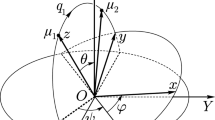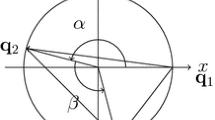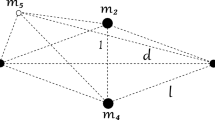Abstract
We use a formulation of the N-body problem in spaces of constant Gaussian curvature, \({\kappa }\in \mathbb {R}\), as widely used by A. Borisov, F. Diacu and their coworkers. We consider the restricted three-body problem in \(\mathbb {S}^2\) with arbitrary \({\kappa }>0\) (resp. \(\mathbb {H}^2\) with arbitrary \({\kappa }<0\)) in a formulation also valid for the case \({\kappa }=0\). For concreteness when \({\kappa }>0\) we restrict the study to the case of the three bodies at the upper hemisphere, to be denoted as \(\mathbb {S}^2_+\). The main goal is to obtain the totality of relative equilibria as depending on the parameters \({\kappa }\) and the mass ratio \(\mu \). Several general results concerning relative equilibria and its stability properties are proved analytically. The study is completed numerically using continuation from the \({\kappa }=0\) case and from other limit cases. In particular both bifurcations and spectral stability are also studied. The \(\mathbb {H}^2\) case is similar, in some sense, to the planar one, but in the \(\mathbb {S}^2_+\) case many differences have been found. Some surprising phenomena, like the coexistence of many triangular-like solutions for some values \(({\kappa },\mu )\) and many stability changes will be discussed.






















Similar content being viewed by others
References
Borisov, A.V., Mamaev, I.S., Kilin, A.A.: Two-body problem on a sphere. Reduction, stochasticity, periodic orbits. Regul. Chaotic Dyn. 9, 265–279 (2004)
Chernoïvan, V.A., Mamaev, I.S.: The restricted two-body problem and the Kepler problem in the constant curvature spaces. Regul. Chaotic Dyn. 4, 112–124 (1999)
Diacu, F.: Relative Equilibria of the Curved \(N\)-Body Problem Atlantis Studies in Dynamical Systems, vol. 1. Atlantis Press, Amsterdam (2012)
Diacu, F.: Polygonal homographic orbits of the curved 3-body problem. Trans. Am. Math. Soc. 364, 2783–2802 (2012)
Diacu F (2014) Relative equilibria of the 3-dimensional curved \(n-\)body problem. Mem. Am. Math. Soc. 228(1071)
Diacu, F.: The classical \(N\)-body problem in the context of curved space. Can. J. Math. doi:10.4153/CJM-2016-041-2.
Diacu, F.: Bifurcations of the Lagrangian orbits from the classical to the curved 3-body problem. arXiv:1508.06043
Diacu, F., Martínez, R., Pérez-Chavela, E., Simó, C.: On the stability of tetrahedral relative equilibria in the positively curved 4-body problem. Phys. D. 256–257, 21–35 (2013)
Diacu, F., Pérez-Chavela, E.: Homographic solutions of the curved 3-body problem. J. Differ. Equ. 250, 340–366 (2011)
García-Naranjo, L.C., Marrero, J.C., Pérez-Chavela, E., Rodríguez-Olmos, M.: Classification and stability of relative equilibria for the two-body problem in the hyperbolic space of dimension 2. J. Differ. Equ. 260, 6375–6404 (2016)
Kilin, A.A.: Libration points in spaces S2 and L2. Regul. Chaotic Dyn. 4, 91–103 (1999)
Kozlov, V.V., Harin, A.O.: Kepler’s problem in constant curvature spaces. Celest. Mech. Dyn. Astron. 54, 393–399 (1992)
Kozlov, V.V.: Problemata nova, ad quorum solutionem mathematici invitantur. Dynamical systems in classical mechanics. Am. Math. Soc. Transl. Ser. 2, 168, pp. 239–254. Am. Math. Soc., Providence, RI, (1995)
Martínez, R., Samà, A., Simó, C.: Stability diagram for 4D linear periodic systems with applications to homographic solutions. J. Diff. Equ. 226, 619–651 (2006)
Martínez, R., Samà, A., Simó, C.: Analysis of the stability of a family of singular–limit linear periodic systems in \({\mathbb{R}}^{4}\) Applications. J. Diff. Eqs. 226, 652–686 (2006)
Martínez, R., Simó, C.: On the stability of the Lagrangian homographic solutions in a curved three-body problem on \({{\mathbb{S}}^{2}}\). Discrete Contin. Dyn. Syst. A. 33, 1157–1175 (2013)
Siegel, C.L., Moser, J.K.: Lectures on Celestial Mechanics. Springer, Heidelberg (1971)
Simó, C.: Analytical and numerical computation of invariant manifolds. In Benest, D., Froeschlé, C. (eds) Modern Methods in Celestial Mechanics, pp. 285–330. Editions Frontières (1990)
Simó, C., Sousa-Silva, P., Terra, M.: Practical Stability Domains near \(L_{4,5}\) in the Restricted Three-Body Problem: Some preliminary facts. In Ibáñez, S. et al. (eds) Progress and Challenges in Dynamical Systems, 54, pp. 367–382. Springer, Berlin (2013)
Szebehely, V.: Theory of Orbits. Academic Press, New York (1967)
Zhu, S.: Eulerian relative equilibria of the curved 3-body problems in \({{\mathbb{S}}^2}\). Proc. Am. Math. Soc. 142, 2837–2848 (2014)
Acknowledgements
This research has been partly supported by grant 2014 SGR 1145 (Catalonia) and grant MTM2013-41168-P (Spain). The authors are indebted to A. Borisov, F. Diacu and E. Pérez-Chavela for helpful discussions, to the referee for helpful suggestions and to the organizers of the conference on Global Dynamics in Hamiltonian Systems for allowing them to present the results on this event.
Author information
Authors and Affiliations
Corresponding author
Appendix
Appendix
In this Appendix we give reduced formulas for the functions which appear in the equations of the restricted problem.
Let us consider the functions \( \rho _{ij}, f_{ij}, g_{ij} \) defined in (5). It is easy to check that they can be written as
where \( E_i=\sqrt{1- {\kappa }(\xi _i^2 + \eta _i^2)}. \)
If \( \mathbf{U}_1=(\xi _1,\eta _1)^T=(r_1,0)^T,\) \(\mathbf{U}_2=(\xi _2,\eta _2)^T=(-r_2,0)^T, \) \( \mathbf{U}_3= (\xi _3,\eta _3)^T = (x,y)^T, \) then
where \( E_j= \sqrt{1-{\kappa }r_j^2}, \) \( j=1,2\), \(E_3 = \sqrt{1-{\kappa }(x^2 + y^2)} \). Then one has
and, furthermore
Lemma 7.1
Assume \({\kappa }>0\) and \(r_1,r_2\) fixed. Then \( f_{13} \) and \( f_{23} \) are convex functions in \( C_{{\kappa }}:=\{ (x,y)\in \mathbb {R}^2 \,|\,{\kappa }(x^2+y^2) < 1 \} \), such that for any \( (x,y) \in C_{{\kappa }} \)
Moreover \(f_{13}=0 \) along the curve \( \gamma _{13} = \{ (x,y) | x \le 0, {\kappa }(x^2 + E_1^2 y^2 ) = E_1^2 \} \), and \( f_{23}=0 \) on the curve \( \gamma _{23} = \{ (x,y) | x \ge 0, {\kappa }(x^2 + E_2^2 y^2 ) = E_2^2 \} \).
If \({\kappa }<0\), then \(f_{13}>0\) and \(f_{23}>0\) at any point.
Proof
Using
it follows that the Hessian of \(f_{13} \) is negative definite in \(C_{{\kappa }}\). Similar formulas hold for \(f_{23}\) by replacing \(E_1\) by \(E_2\). The maximum for \(f_{13}\) is equal to 1 and it is attained at the point \((x,y)=(r_1,0)\) and the minimum is achieved at the point \((x,y)= (-1/\sqrt{{\kappa }},0).\) Similar for \(f_{23}\). The case \({\kappa }<0\) is obvious from (3). \(\square \)
Let us consider the functions \( {\hat{F}} \), \( {\hat{G}} \) introduced in Sect. 6. We compute the partial derivatives
Lemma 7.2
For any real \({\kappa }\), the following identity holds
Proof
From (59) it follows
Note that from (55), \( \Delta _{13}^{-5/2} (y^2 + S_1^2) = \Delta _{13}^{-3/2}= g_{13} \) and \( \Delta _{23}^{-5/2} (y^2 + S_2^2) = g_{23} \). Using (56) to write
one can easily obtain (60) after some cancellations. \(\square \)
Rights and permissions
About this article
Cite this article
Martínez, R., Simó, C. Relative equilibria of the restricted three-body problem in curved spaces. Celest Mech Dyn Astr 128, 221–259 (2017). https://doi.org/10.1007/s10569-016-9750-8
Received:
Revised:
Accepted:
Published:
Issue Date:
DOI: https://doi.org/10.1007/s10569-016-9750-8
Keywords
- N-body problem in curved spaces
- The restricted three body problem in curved spaces: relative equilibria
- Totality of solutions
- Bifurcations
- Changes of the spectral stability




